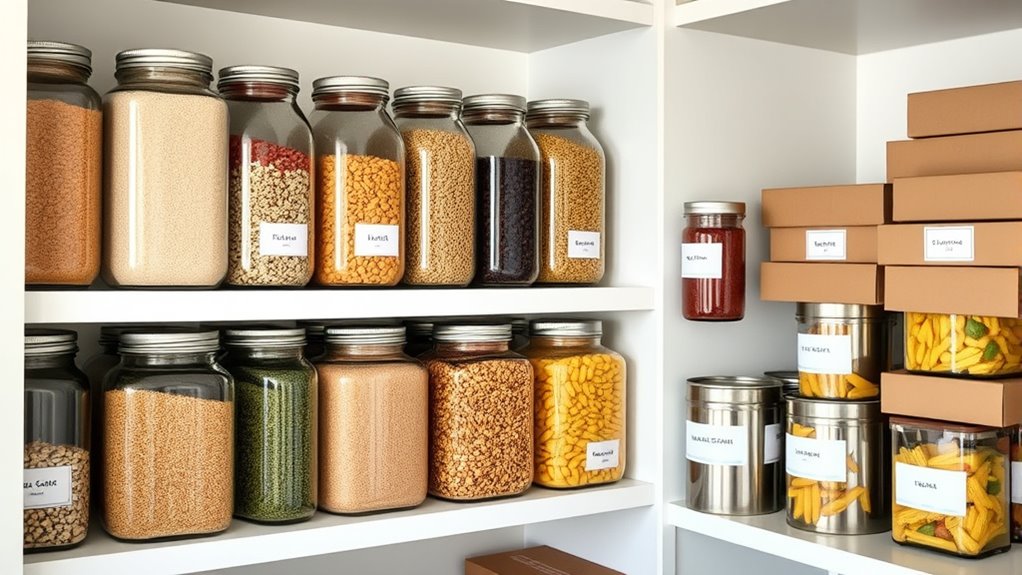To plan a non-perishable pantry effectively, you’ll want to start by evaluating your space and choosing smart storage solutions like airtight containers and adjustable shelving. Stock essentials such as grains, canned proteins, and dried goods, organizing them by category for easy access. Maintain your stock by rotating items regularly and using labels with purchase dates. Smart shopping, creative meal prep, and ongoing organization make pantry management simple—keep going to uncover more tips to boost your kitchen efficiency.
Key Takeaways
- Assess available storage space and organize with adjustable shelves, labels, and clear containers for easy access and inventory management.
- Stock essential staples, proteins, and grains, storing them in airtight containers for freshness and quick meal prep.
- Use creative seasoning and combinations of canned and dried ingredients to maximize flavor and variety in simple dishes.
- Maintain organized inventory, rotate stock regularly, and shop smart by buying in bulk and tracking expiration dates.
- Incorporate decorative and technological elements to create an inviting, efficient pantry environment that simplifies maintenance.
Assessing Your Space and Storage Needs

Before you start filling your pantry, it’s essential to evaluate the space you have available. Look at your storage area and consider shelving options that maximize space. Adjustable shelves can help accommodate different-sized containers and keep everything organized. Think about climate considerations, too—if your pantry is in a humid or hot area, you’ll want to choose storage solutions that protect your non-perishables from moisture and temperature fluctuations. Ventilated shelving or airtight containers can help maintain freshness. Measure your space carefully to avoid overestimating what you can store. Remember, functional and flexible shelving options allow for easy access and efficient use of space. Proper assessment now makes future shopping and organizing much smoother. Incorporating storage solutions designed for your specific environment can further enhance the longevity and accessibility of your pantry items.
Picking the Essentials: Staples for Every Pantry

To keep your pantry well-stocked, focus on common shelf staples like canned goods and dried foods that last long. Include long-lasting proteins such as canned tuna or beans, and choose versatile grains like rice or pasta to create quick meals. These essentials form the foundation for a practical and reliable non-perishable pantry. Incorporating wall organization systems can also help you efficiently store and access your pantry items.
Common Shelf Staples
Having a well-stocked pantry starts with choosing the right shelf staples that are versatile, long-lasting, and essential for everyday cooking. These staples should be easy to identify and store. Use clear shelf labels to organize different categories, like grains or spices, making it simple to find what you need. Container types also matter—opt for airtight jars, bins, or canisters to keep items fresh and accessible. Proper conflict resolution skills can help maintain harmony when organizing shared spaces like the pantry. Here’s a quick visual:
| Item | Container Type |
|---|---|
| Rice | Airtight jar |
| Pasta | Plastic bin |
| Canned tomatoes | Canning jars |
| Flour | Clear canister |
| Sugar | Sealed container |
These staples form the foundation of your pantry, ensuring you always have ingredients on hand for quick, nutritious meals.
Long-Lasting Proteins
Long-lasting proteins are essential for guaranteeing your pantry can support nutritious meals over time. Proper protein preservation means choosing items that won’t spoil quickly, so you always have options on hand. Canned meat options like tuna, chicken, and salmon are excellent because they stay good for years and are easy to incorporate into various dishes. Dried beans, lentils, and chickpeas also provide protein and have a long shelf life when stored properly. For added variety, consider freeze-dried or vacuum-sealed meats, which retain quality longer. Stocking these products ensures you have reliable sources of protein, even during emergencies or busy days. By selecting a mix of canned and dried options, you create a resilient foundation for your pantry that supports your nutritional needs over time. Additionally, exploring shelf-stable meat options can further diversify your protein sources without sacrificing longevity.
Versatile Grains
Versatile grains are the backbone of a well-stocked pantry because they serve as affordable, nourishing staples that can be used in countless meals. Stocking a variety of grain varieties like rice, oats, quinoa, and barley guarantees you’re prepared for breakfast, sides, or main dishes. To maximize shelf life, store grains in airtight containers in a cool, dry place, away from sunlight and moisture. Proper storage techniques prevent spoilage and pest infestations. Keep different grains labeled and organized for easy access. Consider rotating older stock to ensure freshness. Having a range of versatile grains on hand allows you to create hearty, nutritious meals quickly, making your pantry both practical and adaptable for everyday cooking needs. Shelf life can vary depending on the grain type and storage conditions, so understanding proper preservation methods is essential for maintaining quality.
Organizing for Efficiency and Accessibility

To make your pantry both efficient and easy to navigate, start by grouping similar items together and assigning each category a designated space. Use clear labeling systems to identify contents quickly, especially for canned goods and baking supplies. Incorporate canning techniques to store jars upright and prevent spills, making access smoother. Arrange items by frequency of use—place everyday essentials at eye level and less-used items on higher or lower shelves. Keep frequently accessed categories near the front. Use stackable containers for dry goods to save space and maintain order. Regularly check expiration dates and rotate stock to avoid waste. Additionally, understanding self-watering systems can inspire innovative storage solutions that maintain freshness and reduce the need for constant replenishment. Staying organized allows you to find what you need faster and keeps your pantry tidy, saving time and reducing stress during busy days.
Shopping Smart: Tips for Budget-Friendly Buying

Efficient pantry organization can help you spot what you already have, preventing duplicate purchases and unnecessary spending. When you create detailed shopping lists, you avoid impulse buys and stick to essentials. Look for bulk discounts on staples like rice, beans, and canned goods—they save money over time. Use your organized pantry to identify what needs replenishing before heading to the store. Comparing prices and buying in bulk can considerably cut costs. Keep a running list based on your meal plans and current stock, so you only buy what’s necessary. This approach smooths out your shopping routine and ensures you’re getting the most value. Additionally, understanding grocery savings strategies can further maximize your budget.
Maintaining and Rotating Your Stock

Regularly maintaining and rotating your pantry stock keeps your supplies fresh and prevents waste. Check expiration dates regularly and prioritize using items that are nearing their expiry. Implementing stock rotation guarantees older items are used first, reducing the chance of spoilage. When restocking, place new items behind older ones to remind you to use the older stock first. Keep your pantry organized so you can easily see what you have and avoid overbuying. Discard anything past its expiration date or visibly spoiled to maintain food safety. Consistent maintenance helps you stay aware of your inventory, minimizes waste, and keeps your pantry ready for emergencies. Additionally, applying food safety principles ensures your stored items remain safe and effective for longer periods. With a systematic approach to stock rotation, you’ll save money and ensure your non-perishables stay safe and effective.
Creative Ways to Use Non-Perishables in Meals

Non-perishables often get a bad rap as boring staples, but with a little creativity, you can turn them into exciting and flavorful meals. Use meal prep hacks and flavor enhancement techniques to elevate simple ingredients. For example, you can:
- Mix canned beans with spices and olive oil for hearty salads
- Turn dried pasta into flavorful stir-fries with canned vegetables and sauces
- Add canned tuna or chicken to instant rice with herbs for quick protein boosts
- Use instant oats for savory breakfast bowls with spices and nuts
- Incorporate canned tomatoes into homemade sauces or soups, enhancing depth with herbs and garlic
- Incorporate rustic decor elements to create a cozy kitchen atmosphere that inspires meal creativity.
These ideas help you make the most of your pantry, keeping meals interesting while maximizing shelf-stable ingredients. Creativity and seasoning are key to transforming non-perishables into delicious dishes.
Troubleshooting Common Pantry Planning Challenges

Even with a creative approach to using pantry staples, planning can still pose challenges, especially when juggling limited ingredients and unpredictable schedules. One common issue is keeping track of what’s available, which is where labeling systems come in. Use clear labels with purchase dates to easily identify older items nearing expiration. Regular expiration tracking helps prevent waste and ensures you use ingredients at their freshest. When planning meals, consult your labels and expiration dates to avoid buying duplicates of ingredients you already have. If you notice items nearing their expiration, plan quick, simple recipes around them. Staying organized with a consistent labeling system and routine expiration checks minimizes waste, saves money, and keeps your pantry functional even during busy weeks. Incorporating AI data analysis can also help you anticipate your pantry needs based on past usage patterns, making planning even more efficient.
Frequently Asked Questions
How Often Should I Audit My Pantry Inventory?
You should audit your pantry inventory every three to six months to stay on top of expiration dates and maintain proper inventory turnover. Regular checks help you use items before they expire, avoid waste, and identify what needs restocking. By keeping a consistent schedule, you guarantee your pantry stays organized, fresh, and ready for any meal, saving you time and money in the long run.
What Are Signs My Non-Perishables Have Gone Bad?
You’ll know your non-perishables have gone bad if they’re past their expiration dates or show signs of mold growth. Check for unusual odors, discoloration, or a strange texture. If packaging is bulging, cracked, or leaking, it’s a warning sign. Always discard items that smell off or have visible mold, as consuming them could make you sick. Regularly inspecting your pantry helps catch these issues early.
How Can I Prevent Pests in My Non-Perishable Stock?
Think of your pantry as a fortress against pests. To keep rodents out, store your non-perishables in rodent-proof containers that seal tightly, like a treasure chest. Use natural repellents such as peppermint oil or dried lavender around shelves, which pests dislike. Regularly check for signs of intruders, and keep your pantry clean and dry. These simple steps create a hostile environment for pests, protecting your stock effectively.
What Are Eco-Friendly Storage Options for Non-Perishables?
You can choose eco-friendly storage options like biodegradable containers and reusable storage bins to keep your non-perishables organized. These options reduce plastic waste and are safer for the environment. Use biodegradable containers for dry goods, and opt for sturdy reusable bins to store larger items. By switching to these eco-friendly choices, you help protect the planet while maintaining a practical and sustainable pantry.
How Do I Handle Allergies With Stored Non-Perishable Foods?
You handle allergies with stored non-perishable foods by choosing allergy-friendly alternatives and carefully reading labels. Always check for potential allergens and look for products marked as allergy-friendly. Implement label reading strategies like scanning for common allergens and avoiding cross-contamination risks. Keep separate storage containers if needed, and stay informed about ingredient changes to guarantee your pantry remains safe and suitable for your allergy needs.
Conclusion
Now that you’ve got the scoop on pantry planning, you’re ready to turn your kitchen into a well-organized fortress of non-perishables. Think of it as your own secret lair—stocked, efficient, and prepared for anything, even a sudden visit from a knight in shining armor. Keep it simple, stay consistent, and you’ll master the art of pantry management. Before you know it, you’ll be a culinary wizard, conjuring up meals faster than you can say “huzzah!”









